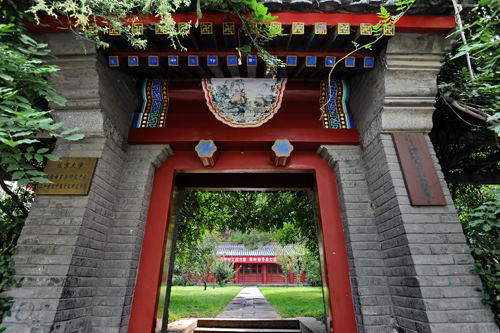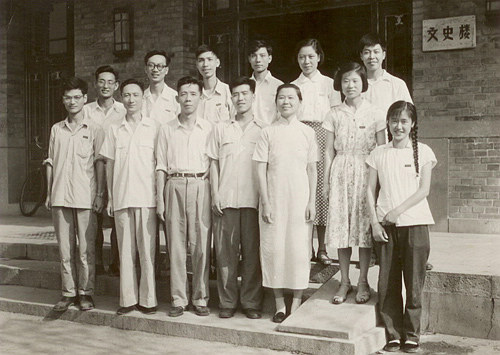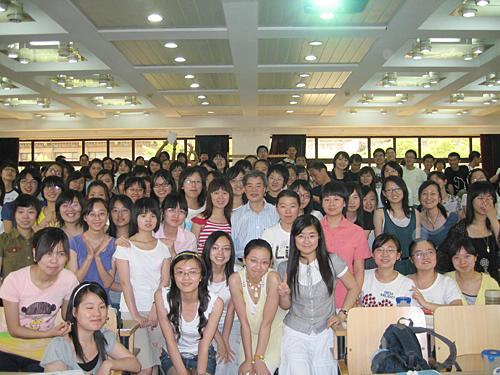Peking University, Sept. 19, 2010: As the academically and socially influential Department of Chinese Language and Literature (DOCLL) of Peking University celebrates its centennial this year, Beijing Review reporter Tang Yuankai recently interviewed Wen Rumin, professor and former Dean of the DOCLL. Excerpts follow:

Very Chinese: The gate to the compound of the Department of Chinese Language and Literature at Peking University (Yu Xiangjun)
Beijing Review: Could you tell us about the development of this department and its contributions to China's education and society?
Wen Rumin: Peking University was founded in 1898 as China's first national university in the modern sense and was originally known as the Imperial University of Peking (Jingshi Daxuetang). Back then, the university didn't have a Chinese language department. In 1904, the university was divided into several disciplines: studies of Confucian classics, political science and law, literature, medicine, agriculture, engineering, and business. Every discipline had several branches. The literature discipline had nine branches, including the branch of Chinese literature, which could be regarded as the origin of today's DOCLL.
On Mar. 31, 1910, the Imperial University of Peking was divided into seven schools and each consisted of several departments. The school of humanities included two departments: Chinese Literature Department and Foreign Literature Department. Both departments offered courses of four years' duration. Schools and departments were relatively independent units of teaching. The Chinese Literature Department enrolled 38 students for its inaugural class. The founding of this department marked the first time Chinese language and literature became a special discipline of China's higher education.
In 1917, after being appointed president of then National Peking University, the famous scholar Cai Yuanpei recruited many liberal and foreign-educated scholars, including Chen Duxiu, one of the initiators of the anti-Confucius New Culture Movement and founders of the Communist Party of China. These scholars opposed traditional Chinese literature and advocated the use of vernacular literature in the Chinese Literature Department and the school of humanities. Peking University became the battleground between orthodox and new schools of thought, as well as a center of humanities studies and enlightenment.
Over the next century, the development of the DOCLL can mainly be divided into the following stages. The first period was around 1919, which featured the establishment of its own teaching models. The second period was in the 1920s and 1930s, when the synergy between Western researching methods and traditional Chinese researching methods was created. The third phase started in 1937, when Japanese invaders launched their all-out war against China. In the same year, Tsinghua University, Peking University, and Nankai University were forced to move to Changsha in southwest China. In April 1938, the three universities moved to Kunming of Yunnan Province in south China and merged to form National Southwest Associated University. The Chinese departments of Peking University and those of Tsinghua University merged into one. During the fourth period between 1950 and 1966, the Chinese departments of several universities merged into the Chinese Department of Peking University, making this period a heyday for the department academically. The fifth phase was the "cultural revolution" (1966-76), when the teaching and academic studies in the department were disrupted. The sixth phase was in the early 1980s, which featured a liberal atmosphere and active and productive teaching and research. The seventh phase is from the 1990s to today, which features the expansion of our education and research.
Over the last century, nearly 20,000 people have studied in our department if foreign students, auditors, and short-term training courses students are included. Our alumni have become elites in all sectors of the society.
Over its development, the DOCLL exerted the largest social impact during the New Culture Movement and the May Fourth Movement, a famous cultural and political movement in 1919. The two most academically productive periods in its history were between the 1920s and 1930s and in the early 1980s respectively. However, students with true scholarship can be found at each stage of the department's history.

Youth in Black and White: Students and professors of the Department of Chinese Language and Literature of Peking University in front of their teaching building in 1950 (Courtesy of DOCLL)
Beijing Review: As the DOCLL is the most prestigious teaching institution of Chinese language, could you tell us the characteristics of its academic style and teaching?
Wen Rumin: The department's academic atmosphere, highlighting freedom, rigorousness, and practicality, has never changed during its 100-year history. The faculty of the department always includes professors who are the most knowledgeable in the Chinese language among their peers. Some of these professors are graduates from Peking University while others are not. They are attracted to teaching positions in the department by its prestige and its free atmosphere, which has become one of our most cherished traditions.
Meanwhile, we give equal emphasis to a rigorous and practical approach to studies. The department's best-known courses, such as history of literature, history of the Chinese language and bibliography and textual criticism, have emphasized the use of materials and accurate evidence.
In terms of our teaching style, our department requires the students to build a solid knowledge base of the Chinese language and then gives them the leeway to explore areas they are interested in. The graduates from our departments work in different fields other than academic studies, and many of them have become very successful. A high percentage of our graduates turned out to be very competitive in their areas.
Beijing Review: What are the main teaching contents of the department?
Wen Rumin: As the name of our department indicates, we mainly teach Chinese language and literature. But we also teach courses on Chinese history, culture, and even foreign literature and culture. Courses for bachelor's degree students include ancient Chinese, modern Chinese, theory of literature and art, linguistics, ancient literature, modern literature, foreign literature, comparative literature, Chinese and foreign history, and culture. Master's degree and doctor's degree candidates study even more courses, some of which are cross-discipline courses.
Despite opening many literature courses, we don't intend to train writers, as writers are usually not produced by university education. The courses for our students are basic ones to give them excellent writing skills and cultural knowledge.
Beijing Review: Except for teaching, what are the DOCLL's major achievements in academic research?
Wen Rumin: The academic influence of the DOCLL reached its pinnacle during the May Fourth Movement. Back then, Peking University was the base camp for new thinking in China. Important figures of the ensuing New Culture Movement, such as Lu Xun and Hu Shi, were professors at the DOCLL. Many people criticized the May Fourth Movement for severing the links between new culture and tradition. As a matter of fact, the DOCLL was the pioneer in China in the research of ancient Chinese novels, ancient books collation, and modern linguistics, which were started by scholars supporting the May Fourth Movement.
Over the century, the teaching and research activities of the DOCLL have always centered an modernization and the formation of new academic guidelines. By combining Western research methods and Chinese traditional research methods, professors of the DOCLL have authored a large number of works that represent the highest level of their fields. I edited a two-volume collection of the most important works of more than 60 famous scholars who once taught at the DOCLL. The book, published in 2007, exhibited these masters' research achievements in the history of literature, linguistics, and ancient texts.
Beijing Review: The DOCLL seems to be the department with the largest number of foreign students in Peking University. How are they taught and trained?
Wen Rumin: The DOCLL started to recruit foreign students beginning in the 1940s. In the 1950s, most foreign students were from the former Soviet Union, Czech, Poland, Romania, Viet Nam, and the Democratic People's Republic of Korea and most were funded by government scholarships and studied for a bachelor's degree. They took compulsory courses in the first two years and started to select courses according to their needs from the third year. The education for these students was elite education, which equipped them with proficiency in Chinese and high research capacities. Most of them became sinologists or diplomats.
At the beginning of the 1980s, the enrollment of foreign students has rose steadily and most of them came from developed countries, such as Japan, the Republic of Korea, the United States, and EU countries. The students are mainly self-funded.

Language Fans: Wen Rumin (center), a professor of Department of Chinese Language and Literature at Peking University, with his students in 2009 (Courtesy of DOCLL)
The DOCLL received around 30 foreign students on average annually. Foreign students used to study in the same classes with Chinese students. Since the beginning of the 1990s, they have studied in separate classes and used curriculums designed for them. Courses for foreign students are easier. For example, their literature history course contains more contents on analyzing famous works and less "history" contents. Different from Chinese students, foreign students have some special compulsory courses, such as Chinese writing, Chinese calligraphy, and Chinese culture.
The DOCLL conducted another round of reform of foreign students' curriculum in 2004 by cutting off some research-based courses and increasing practical courses on learning Chinese; emphasizing the learning of oral Chinese and Chinese writing; adding new courses on Chinese history and economic and political situations. The goal of teaching foreign students has switched from producing sinologists or scholars to producing fluent speakers of Chinese.
As for students studying for a master's degree or a doctor's degree, we received more than 10 foreign students on average annually in the late 1990s. But the number has been shrinking in recent years. They are trained the same way as Chinese students.
The DOCLL also receives short-term foreign students and visiting scholars, whose total number surpasses that of its bachelor's degree students. Since the late 1980s, the DOCLL receives 60 short-term foreign students and visiting scholars on average every year. These students are mainly freshman or sophomore students from Japan and the Republic of Korea who study in the DOCLL for one semester or two months. They have tailor-designed curriculum, whose major part is the learning of basic Chinese.
Visiting scholars are mainly professors from foreign universities, many of whom are famous sinologists and bring their research topics with them. They teach some courses at the DOCLL and devote a lot of time to communicating with other professors. The most well-known sinologists in the world have almost all once been visiting scholars at the DOCLL, making the department a platform for international academic exchange.
We have also organized Chinese learning camps for foreign students during summer and winter vacations. The students mainly come from Japan, the Republic of Korea, and the United States. They are usually brought to China by a university in their own country in a group between 20 and 60 students and pay all the expenses themselves. Their one-month courses usually include lessons on basic Chinese and Chinese culture and a tour to other places of China.
Reported by: Tang Yuankai
Edited by: Su Juan
Source: Beijing Review